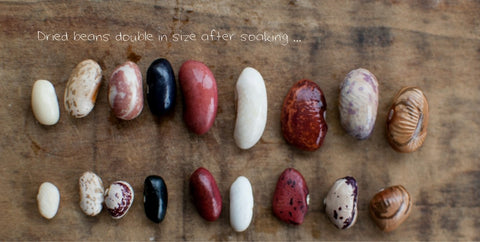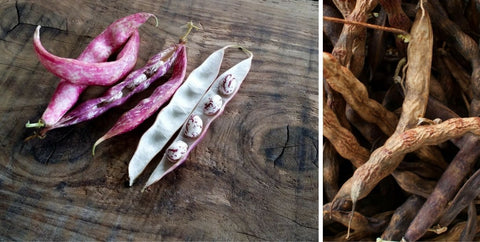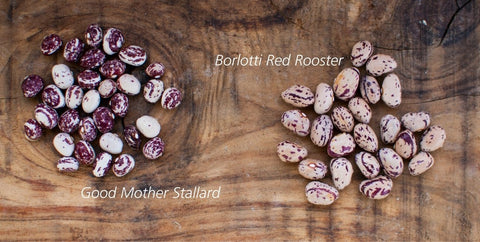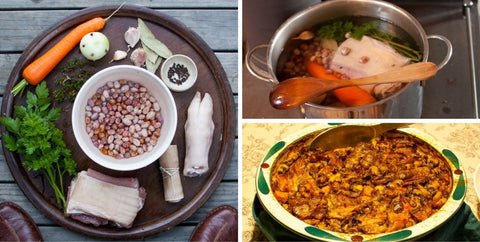Dried beans have a bit of an image problem, at least for me they do. I have memories of student days and the flexing of aspiring culinary muscles with the help of the "Bean Booklet" from Real Foods in Andersons Bay. Each of the dozen recipes ended up tasting like wet cardboard and made the whole flat windy. Perhaps I should have guessed from the image of a squirrel on the front.

It turns out dried beans are by no means restricted to poor students and fibre addicts. A good chunk of the world relies on legumes for their primary protein source and know how to make them taste good. So twenty years on I decided to put the trauma of "Black Eye Bean Bake" and "Lazy Lentils" behind me and give beans a chance.
I have my finger on the pulse (sorry couldn't help it) - beans are good for us and the planet. They are low in fat and high in fibre and protein. Beans also take less energy and water to grow and they improve soil health.

I set aside two garden beds, and with the help of Mark Christensen, Research Director at the Heritage Food Crops Research Trust, I selected 13 dried or "shell out" bean varieties to grow. Mark sent me some of the climbing bean varieties that the Research Trust imported from North America. I added a selection of “good beans” gifted to me and a few common bush varieties used for dried beans to round out the trial.
RT, Research Trust, HC, Heathers Collection, EG, Egmont Seeds.
Climbing Beans
- Persian Climbing Lima (RT)
- Good Mother Stallard (RT)
- Indian Hannah (RT)
- Blue Shackamaxon (RT)
- Ian’s French Tarbais (HC)
- Ron’s Factory Bean (HC)
- Rex & Margie’s Bean (HC)
Bush Beans
- Red Kidney (EG)
- Dwarf Haricot (RT)
- Dwarf Cannelini (RT)
- Soy Bean (Kiwi #8) (EG)
- Mexican Pinto (HC)
- Borlotti Red Rooster (EG)
Growing
Beans like warm soil. Here in Nelson, I sowed them directly into the garden in early November. Don’t be tempted to plant beans too early. If the soil is cold, they will sit and rot, or germinate then decide against climbing anywhere. By the time the soil is warm, they’ve exhausted all their energy surviving, and they give up.

Climbing beans need a good frame to run-up. I opted for reinforcing mesh secured with 2m high stakes. Spacing for beans varies but as a guide, sow climbing beans 25 cm apart and bush bean 15 cm apart.
Beans are relatively free of pests and diseases and shouldn’t need spraying. Just keep an eye out for the usual suspects – aphids, green shield bugs and caterpillars. I got a mystery affliction in my trial beans. After germinating, the young leaves of several varieties started yellowing and crinkling and the tips were dying off and refusing to run or bush anywhere. With no obvious gnawing or sucking pests, I was at a loss to discover the problem. It looked like bean mosaic virus but I never got to the bottom of it. It reduced the yield of the affected varieties, but I still got a harvest. I gave them a spray with an organic seaweed-based formula being trialled to combat the PSA virus and they seemed to pick their toes up.
The Varieties
- Of the climbing beans, the Persian Lima was the most vigorous, disease-resistant and prolific and was still flowering well into winter. The flat pods looked more like mangetout and I doubted whether they would produce a good dried bean.
- Good Mother Stallard came highly recommended by Mark and it proved as robust and abundant as its homely name suggested. The beans looked remarkably like Borlotti.
- I grew the large white French bean, Tarbais a few years ago but the remaining seed I had didn’t germinate - I’m annoyed at myself for losing this one.
- Factory Beans were green, stringless beans grown for the canning factory in Motueka, but the fat white seeds suggested they might make a nice dried bean.
- The same goes for the bean that Rex and Margie from Maerawhiti gave my Dad, the plump, stripey, coffee-coloured seeds looked delicious.
- Blue Shackamaxon deserved to be grown just for the name, it also proved to be a good late harvest bean with pods full of black, glossy seeds.
- The Indian Hannah climbing bean is an ancient mix of varieties traditionally grown together by the Lenape/Delaware Indian Nation.
- Of the bush beans, the Dwarf Haricot and Cannelini had a poor strike, and the Soy Beans produced a very small crop, but the Red Kidney, Borlotti Red Rooster, and Mexican Pinto all produced well.
When the beans are growing, encourage them to keep producing by picking a few of the first pods. Once you can see the outline of fat bean seeds tight against the skin of the pods, you can shell them out and cook a few. They cook in very little time and have a melt-in-the-mouth creamy texture.
For dried beans, let the pods mature a few weeks longer on the vine until they start to yellow and wither. If the weather is dry, you can leave them on the vine until the seeds rattle inside crispy brown pods. If it looks like rain, harvest the pods when they start to yellow and dry them on racks inside. Remember to save a few beans to grow again next season

While I waited for the beans to grow I expanded my bean cuisine by reading “Cassoulet – a French Obsession”, a lovely book by Kate Hill. She unpicks each element of this classic French bean and charcuterie dish and writes passionately about beans. Freshness is everything and according to Kate, those jars of beans decorating your shelf for the last few years will be starchy tasting and hard to cook. Don't purchase or hold on to anything over two years old.

Kate also advocates a “love the one you’re with” local philosophy to beans. While in New Zealand she was surprised by the lack of locally grown dried beans and found the imported beans available tough and harder to cook, pointing to irradiation, age or storage as possible culprits. Perhaps there is a gap for a grower to supply a range of gourmet fresh dried beans? Until then the best option for flavour and variety is to grow your own.
Cooking Beans
I was initially disappointed with the size of my harvest for the amount of plot the crop took. That was until I read that dried beans triple in size during soaking and cooking. Other bits of bean lore I discovered to improve my bean cuisine included:
- Soaking dried beans for 8 – 10 hours in a large bowl of cold water softens them before cooking which reduces cooking time and helps them cook evenly. Lentils and other small pulses do not need pre-soaking.
- Discarding the soaking liquid and cooking in freshwater may reduce flatulence, but some say this is a load of hot air and results in loss of flavour in the bean. I tried both and didn’t notice an appreciable difference in taste or breeziness.
- Don’t add any salt or acidic liquids like vinegar until the end of cooking as these can slow down the cooking.
- A teaspoon of oil added to the cooking water can stop the beans foaming.
- Always cook beans on a gentle simmer. Rapid boiling will cause them to split, break up and cook unevenly.
- The best way to test for doneness is to taste the beans. When they are done they will be soft and creamy with no chalkiness, not wet and mushy.
Taste Test
Once the beans were grown, dried and admired, we soaked them overnight and then cooked up each variety in nothing but water. We ate our way through thirteen different varieties, awarding scores and notes on taste and texture. Oh, the things that pass for fun in these parts!

The outstanding winner on the night was Rex and Margie’s Maerawhiti bean with a nutty, sweet flavour and creamy texture. I wish I knew the variety, but I’m sure someone will recognize the seed and enlighten me. Good Mother Stallard came in a close second with a chestnut sweet flavour, and even, creamy texture - much better than the supposed gourmet Borlotti which we rated as a good flavour absorber, but now something of a has-bean by comparison.

The small pretty Persian Lima beans cooked quickly, rated well for flavour and had a uniform creamy paste, but the firm skin held the beans together making this bean well suited to bean salad. Whereas the Mexican Pinto, Blue Shackamaxon and dwarf Haricot would make ideal refried beans with thin skins, creamy paste, and bland flavour.

The soya beans tasted very rich, like the protein parcels they are and the Red Kidney beans were sweet and creamy, crying out for some chilli and tomato. I cooked up some dried Red Kidney Beans from the local bulk bin as a comparison, and they took longer to cook, weren't as sweet, had tougher skins and a flakier, less creamy texture than the home-grown ones. Proof that even in dried beans freshness matters.
Cooking with Dried Beans
A traditional French Cassoulet is a marriage of beans and meats, cooked slowly in a vegetable and herb enriched broth. Such is its place in the cuisine of southwestern France that it has a special earthenware pot, known as a cassole, to cook it in. I decided to attempt one during a wet winter weekend.
Kate Hill's book gives several recipes including the classic Cassoulet where the method and the ritual are as important as the ingredients. This is true slow cooking - a dish to makeover a couple of days, to be enjoyed for a couple of days more. The combination of confit of duck, ham hock, salt pork, and a good Toulouse sausage all in the one pot may seem like a meat overload but the flavours all mingle and contribute to a significantly hearty dish that would be the poorer for omitting any one of them.
The simplicity of the dish means it relies on the quality of the ingredients to make it great. My kiwi cassoulet with the last of my Maerawhiti beans, homemade lamb sausage, lightly pickled pork belly, back fat and foot of a happy free-range pig went well with some winter veggies and herbs from the garden. The only import was some duck confit from France. Even though the meat is significant, this dish is all about the beans.

And if Cassoulet is a bit involved for you, here are three of my new favourite quick n easy recipes for beans and pulses.

My friend Rachel gave me this recipe for Salt & Vinegar Roasted Chickpeas. They make a lovely snack and could be adapted to a range of seasonings. Soak chickpeas in a large bowl of cold water overnight. Drain in a sieve, weigh them and spread on a foil-lined baking sheet. For every 400 grams of soaked chickpeas mix up 50 ml cider vinegar and 5 g of sea salt. Pour the mixture over the chickpeas and bake in a 200°C (390°F) oven for 30 minutes, turning every 10 minutes. Watch them towards the end so they don't burn. Cool completely and store in a glass jar with an airtight lid.
Ribolitta is a classic Italian bean dish that makes the most of dried beans and winter veggies during the colder months. Nigel Slater describes it as "a big fat soup substantial enough to be the main meal". Cook your beans up and keep the cooking water to add to the soup. Chop up onions, carrots, a little celery and cook them in some butter with a bay leaf. Add your cooked beans and bean water. I add chicken stock, but a can of tomatoes is traditional. The soup is often thickened with bread but I like it thinner with the bread served for dunking. Season to taste and stir in a big handful of chopped Kale 10 minutes before serving and a big bunch of chopped Italian flat-leaf parsley a couple of minutes before serving.
This Red Lentil Coconut Curry is a one-pot, no soaking required, hearty meal. In a large saucepan, cook one chopped onion in a little oil or butter, add some grated fresh ginger and garlic to taste and cook for a couple of minutes. Add in some chopped pumpkin, parsnip or sweet potatoes and cook for a further 5 minutes. Season with ground cumin, coriander, turmeric and a little chilli to taste. Stir to mix and add in 1 1/2 cups of red lentils, a can of coconut milk and 2 cups of water. Cook on low for at least 30 minutes, stirring occasionally so it doesn't stick. Season to taste and serve with rice or flatbreads and some chopped coriander leaves. I've dehydrated it for a tasty tramping meal.
Updated - To see how we fared at making our own Baked Beans, pop over to this blog post

